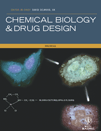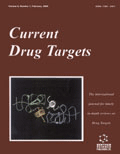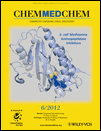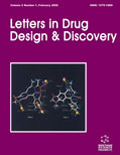
Chemical Biology & Drug Design
Scope & Guideline
Pioneering the intersection of chemistry and medicine for a healthier future.
Introduction
Aims and Scopes
- Medicinal Chemistry:
The journal emphasizes the design and synthesis of novel chemical compounds with potential therapeutic applications, particularly in cancer, infectious diseases, and chronic conditions. - Chemical Biology:
Research that explores the interactions between biological systems and chemical entities, including the mechanisms behind drug action and biological pathways. - Drug Development and Design:
The journal features works related to the development of new drugs, including formulation strategies, delivery systems, and efficacy evaluations. - Network Pharmacology:
A focus on understanding the multi-target interactions of drugs within biological networks, which is essential for elucidating complex disease mechanisms. - In Silico Studies:
Emphasizes computational approaches in drug discovery, including molecular docking, QSAR modeling, and machine learning applications to predict biological activity. - Natural Products Chemistry:
Explores the therapeutic potential of natural compounds and their derivatives, focusing on their isolation, structural elucidation, and biological activities.
Trending and Emerging
- Targeted Cancer Therapies:
An increasing number of studies are focusing on targeted therapies that leverage specific molecular pathways in cancer treatment, reflecting the growing understanding of tumor biology. - Combination Therapies:
Research is trending towards exploring the efficacy of combination therapies that utilize multiple agents to enhance therapeutic outcomes and overcome resistance mechanisms. - Biologics and Biopharmaceuticals:
The emergence of biologics as therapeutic agents, including monoclonal antibodies and protein-based drugs, is gaining traction, emphasizing the need for advanced drug design techniques. - Machine Learning and AI in Drug Discovery:
The integration of machine learning and artificial intelligence into drug discovery processes is becoming increasingly prominent, aiding in predictive modeling and optimization of drug candidates. - Natural Product Derivatives:
There is a growing interest in the modification of natural products to enhance their pharmacological properties, with a focus on their potential as leads for new drug development. - Nanotechnology in Drug Delivery:
Research is increasingly focusing on the application of nanotechnology for drug delivery systems, enhancing the bioavailability and targeting of therapeutic agents.
Declining or Waning
- Traditional Antimicrobial Agents:
Research focusing on conventional antibiotics and their mechanisms has become less prevalent as the field moves towards exploring novel and multi-targeted therapeutic strategies. - Single-Target Drug Design:
There is a noticeable decrease in studies centered around single-target drugs, as the complexity of diseases has led to a shift towards multi-target approaches and combination therapies. - In vitro Only Studies:
Research that solely relies on in vitro models without in vivo validation has waned, as the scientific community increasingly emphasizes the importance of comprehensive in vivo studies to support findings. - Synthetic Methods with Limited Applicability:
The use of traditional synthetic methods without innovative adaptations or applications in drug design has seen a decline, as researchers seek more versatile and efficient synthetic strategies.
Similar Journals

CURRENT DRUG TARGETS
Illuminating Pathways in Clinical BiochemistryCURRENT DRUG TARGETS is a leading peer-reviewed journal dedicated to advancements in the fields of Clinical Biochemistry, Drug Discovery, Molecular Medicine, and Pharmacology. Published by Bentham Science Publishers Ltd, this esteemed journal has solidified its position in the academic community with a 2023 Q2 ranking in several categories, highlighting its influence and relevance in drug research and development. With an ISSN of 1389-4501 and E-ISSN 1873-5592, CURRENT DRUG TARGETS facilitates the dissemination of high-quality articles that explore novel therapeutic strategies and drug design principles. Catered to researchers, professionals, and students, the journal has a commitment to advancing knowledge while addressing contemporary challenges in pharmacological sciences. As it converges from 2000 to 2024, CURRENT DRUG TARGETS remains a vital resource in understanding the complexities of drug action and interaction, making it indispensable for anyone pursuing cutting-edge research in related disciplines.

ChemMedChem
Bridging fundamental science and practical medicine.ChemMedChem is a leading international journal published by WILEY-V C H VERLAG GMBH in the United Kingdom, specializing in the interdisciplinary fields of medicinal chemistry and drug discovery. With a commendable impact factor that places it in the Q1 quartile for Organic Chemistry and among the Q2 ranks in several other key categories including Biochemistry, Molecular Medicine, and Pharmacology, ChemMedChem serves as a vital platform for the dissemination of innovative research and transformative insights in the development of pharmaceutical agents. Since its inception in 2006, this journal has been at the forefront of advancing knowledge that bridges the gap between fundamental research and practical applications in medicine, making it an essential resource for researchers, professionals, and students alike. Although it currently does not offer Open Access options, the journal ensures high-quality peer-reviewed content that engages its audience and fosters collaborative scientific discourse.

Journal of Natural Medicines
Connecting Ancient Wisdom with Contemporary ScienceJournal of Natural Medicines, published by SPRINGER JAPAN KK, is a leading academic journal that plays a pivotal role in the advancement of research in the fields of Complementary and Alternative Medicine, Drug Discovery, Molecular Medicine, Organic Chemistry, and Pharmaceutical Science. Established in 1994 and set to continue until 2024, this journal serves as a vital conduit for the dissemination of groundbreaking research and innovative ideas that bridge traditional medicinal knowledge and modern scientific inquiry. With its impressive ranking in Scopus—ranking #12 out of 105 in Complementary and Alternative Medicine and holding a Q1 category quartile for 2023—it stands as a reputable source for high-quality, peer-reviewed articles. The journal's commitment to excellence is further underscored by its inclusion in the Springer network, providing researchers, professionals, and students with valuable insights and the latest developments in natural medicines. Although this journal operates under a subscription model, its profound impact on these interdisciplinary fields makes it an essential resource for anyone engaged in the study or practice of natural medicinal therapies.

ACS Bio & Med Chem Au
Elevating biomedical research through open access and collaboration.ACS Bio & Med Chem Au, published by the esteemed American Chemical Society, stands at the forefront of interdisciplinary research within the realms of biochemistry, drug discovery, pharmaceutical sciences, and molecular biology. With an impressive Impact Factor indicative of its rigorous academic standards and significant contributions to the field, this open-access journal is committed to disseminating high-quality research that drives innovation and advancements in biosciences and medicinal chemistry. Since its inception in 2021, the journal has rapidly earned recognition, achieving a commendable Q1 ranking in multiple categories, including Biochemistry, Drug Discovery, and Pharmaceutical Science, while also making strides in Molecular Biology. Researchers, professionals, and students alike can explore pioneering studies that bridge gaps between laboratory research and clinical applications, fostering collaborative efforts towards novel therapeutic strategies. With a focus on enhancing accessibility and engagement within the scientific community, ACS Bio & Med Chem Au is poised to impact the future of biomedical research significantly.

RSC Medicinal Chemistry
Transforming Discoveries into Healing SolutionsRSC Medicinal Chemistry is a pivotal journal in the realm of medicinal chemistry, published by the esteemed Royal Society of Chemistry. With a focus on innovative research that intersects various disciplines such as biochemistry, drug discovery, pharmaceutical science, and organic chemistry, this journal serves as a vital resource for researchers, professionals, and students alike. Its impressive impact factor and notable rankings—positioning it within the Q1 and Q2 quartiles across critical categories—underscore its significance in advancing knowledge and fostering collaboration within the scientific community. RSC Medicinal Chemistry is dedicated to open access, ensuring that cutting-edge findings on drug design and therapeutic applications are freely available to enhance global research efforts. With a commitment to publication excellence from 2020 to 2024, it is a prominent platform where groundbreaking ideas meet practical implications, making it indispensable for anyone committed to the forefront of medicinal advances.

Letters in Drug Design & Discovery
Connecting Researchers to Shape Drug DevelopmentLetters in Drug Design & Discovery is an esteemed journal dedicated to advancing the fields of Drug Discovery and Molecular Medicine. Published by Bentham Science Publishers, this journal offers a platform for the dissemination of innovative research and advanced methodologies, enhancing collaboration among researchers and professionals in pharmaceutical sciences. Despite its current Q4 ranking in Drug Discovery and Molecular Medicine and Q3 in Pharmaceutical Science for 2023, the journal is committed to improving its presence in the academic community by providing quality, peer-reviewed publications that cover various aspects of drug design and discovery, including novel therapeutic approaches and methodologies. With a focus on both foundational and cutting-edge research from around the globe, Letters in Drug Design & Discovery is pivotal for those seeking to stay abreast of developments in drug development and molecular research. Researchers are encouraged to submit their work, engage with the burgeoning field, and contribute to the ongoing dialogue driven by this journal, which spans the years from 2005 to 2024. While the journal does not currently offer open access, its contributions remain accessible to a wide range of academic and professional audiences.

Open Chemistry
Illuminating the Path of Chemical InnovationOpen Chemistry, published by DE GRUYTER POLAND SP Z O O, is a distinguished peer-reviewed journal that has been serving the global chemistry community since its inception. With an ISSN of 2391-5420 and an E-ISSN also of 2391-5420, this open-access journal has been accessible to researchers and practitioners alike since 2015, ensuring a wide dissemination of high-quality research findings. Located in Germany, specifically at BOGUMILA ZUGA 32A STR, 01-811 WARSAW, MAZOVIA, POLAND, Open Chemistry aims to publish innovative research across various chemical disciplines, with special attention to miscellaneous chemistry and materials chemistry. It is currently ranked in the Q3 category for both fields as of 2023, reflecting its solid standing within the academic community, with specific ranks of 187/408 in General Chemistry and 153/317 in Materials Chemistry, corresponding to respective percentiles of 54 and 51. Open Chemistry not only enhances the accessibility of cutting-edge research but also serves as a vital resource for students, professionals, and scholars seeking to advance their knowledge in the rapidly evolving landscape of chemical sciences.

Current Research in Structural Biology
Bridging Theory and Practice in Molecular ScienceCurrent Research in Structural Biology, published by Elsevier, is a pioneering Open Access journal that has rapidly gained prominence since its inception in 2019. With a focus on advancing the understanding of molecular and structural biology, this journal provides a platform for researchers and professionals to publish groundbreaking findings that contribute to the field's ongoing development. With a commendable Q2 ranking in both Molecular Biology and Structural Biology categories for 2023, it serves as a vital resource for the community, ensuring accessibility to high-quality research. The journal is indexed in Scopus, showcasing its significant impact and relevance, particularly with a ranking of #26/49 in the Structural Biology discipline. Located in the heart of the Netherlands, Current Research in Structural Biology not only fosters academic discourse but also encourages collaborative research efforts in addressing critical biological questions. Whether you are a researcher, student, or industry professional, this journal is essential for staying abreast of the latest advancements and trends in structural biology.

European Journal of Medicinal Chemistry Reports
Exploring the frontiers of chemistry and molecular medicine.European Journal of Medicinal Chemistry Reports, published by ELSEVIER, is a vital platform dedicated to advancing the field of medicinal chemistry through open access communication of high-quality research. With an impact factor reflecting its growing influence, this journal has rapidly established a reputation for scholarly excellence since its launch in 2021. It serves as a converging point for innovative studies and reviews that span the disciplines of chemistry and molecular medicine, reflected in its Q2 and Q3 quartile rankings in relevant categories for 2023. Situated in France, the journal is accessible globally, ensuring that researchers, professionals, and students can easily engage with significant findings and methodologies in medicinal chemistry. The open access model facilitates the dissemination of knowledge, bridging gaps between laboratory research and practical applications in drug development. By fostering collaboration and highlighting emerging trends, the European Journal of Medicinal Chemistry Reports plays a crucial role in shaping the future of therapeutic innovations.

BIOORGANIC & MEDICINAL CHEMISTRY LETTERS
Pioneering research for a healthier tomorrow.BIOORGANIC & MEDICINAL CHEMISTRY LETTERS, published by PERGAMON-ELSEVIER SCIENCE LTD, is a leading journal in the fields of biochemistry, drug discovery, and medicinal chemistry, designed to disseminate significant advances in these disciplines. Established in 1991, the journal spans various important categories, including Organic Chemistry and Pharmaceutical Science, with its 2023 Scimago Journal Rank placing it at Q2 in Organic Chemistry and Q3 in several other relevant fields. Though not an open-access publication, it provides invaluable insights into contemporary research and innovative methodologies, appealing to researchers, professionals, and students alike. The journal's commitment to quality and relevance makes it a vital resource for those aiming to stay at the forefront of bioorganic and medicinal chemistry developments. For more information, please visit the journal's website as it remains a critical platform for scholarly exchange, particularly for those engaged in interdisciplinary research.